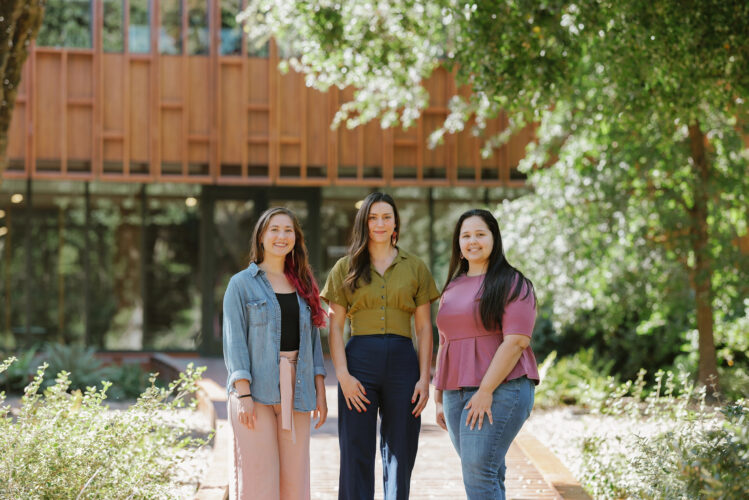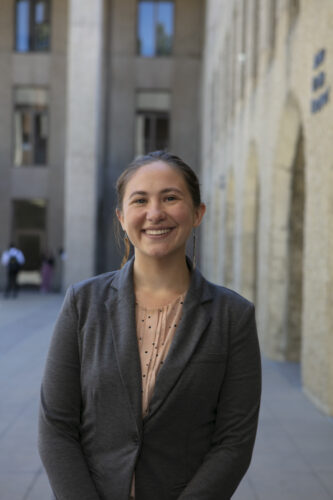Meet Carson Smith, SLS Student and Knight-Hennessy Scholar
Meet three Knight-Hennessy scholars pursuing projects with impact
Three Stanford graduate students and Knight-Hennessy scholars are using their fellowship to support Native and Indigenous communities, both on and off campus.
(Originally published by Stanford Report on October 9, 2023)
When students arrive at a university to begin their studies, one indicator of their success is often how connected they feel to their campuses. Stanford graduate student and Knight-Hennessy scholar Jasmyn Burdsall said this is particularly true of underrepresented students, like those from Native and Indigenous communities.
“Research shows us that the more access to indigenized spaces that Native students have, the better their educational and mental health outcomes are,” Burdsall said, adding that they are more likely to finish their degrees and have lower incidences of anxiety and depression.

Last year, Burdsall and fellow Stanford graduate students and Knight-Hennessy scholars Carson Smith and Karli Moore formed the Native American Graduate Student Wellness Coalition, a KHeystone project at Knight-Hennessy Scholars that focuses on improving wellness for Native graduate students at Stanford. Its goal is to better understand that population and support their degree progress and overall well-being by connecting them to resources and an on-campus community.
Smith said that Stanford’s undergraduate Native community is relatively large and well supported, in part because the undergraduate experience is more centralized. But with graduate admissions and study taking place at the departmental level and some graduate students living off campus, it can be difficult to reach and convene them.
“Graduate students might not even know that there’s a Native graduate community that they can plug into,” Smith said. “This project is a way of getting everybody together.”
Project initiatives include developing a toolkit to help make admissions for prospective Native students more equitable, identifying the number of Native Stanford students, hosting events like presentations by wellness professionals, and organizing social opportunities like dinners, beading circles, and the first Native graduate student retreat this winter. The project is supported by close partnerships with other students, the Native American Cultural Center, and Knight-Hennessy Scholars.
“We are so inspired by the work that Carson, Jasmyn, and Karli are doing to support Indigenous communities,” said Tina Seelig, Knight-Hennessy Scholars executive director. “Their projects have a profound impact on the entire KHS community by exposing our scholars to issues faced by Indigenous groups that they might never have known about otherwise. This is true with so many members of our highly diverse community, who provide a wealth of perspectives on the world.”
With backgrounds in medicine, law, and environmental science, Burdsall, Smith, and Moore are uniquely qualified to improve the Native graduate student experience on campus. However, their efforts to support Native communities are not limited to Stanford.
Carson Smith, JD ’25
Carson Smith is from the Chicagoland area of Illinois and is a member of the Choctaw Nation. She is pursuing a JD at Stanford Law School. She graduated with honors from Stanford with a bachelor’s degree in political science and a minor in Native American studies. She is interested in improving peacemaking processes in tribal communities.

Smith said that Western court systems aren’t always effective in small tribal communities, many of which have had their own conflict resolution systems for centuries. Much of her work and research aims to support and develop alternative dispute resolution systems and tribal courts that are community-based and cognizant of cultural matters.
“When you have a tribe that is small, community connections are so important,” Smith said. “So having a system that will maintain familial and community relationships is extremely important, because if you don’t have those you can’t govern.”
Today, peacemaking is mostly used to navigate issues involving tribal community members, such as family disputes, probate, criminal offenses, or child welfare concerns. But Smith sees the potential for such Indigenous conflict resolution processes to be used to mediate conflicts between tribes and other groups, like governments or corporations.
Smith has worked as a Conflict Resolution Fellow at Stanford University, where she has guided the mapping and redesign of multiple university conflict resolution processes, taught several courses, and acted as a peacemaker. She is also an advisory board member for the Native American Rights Fund’s Indigenous Peacemaking Initiative. She hopes to apply her scholarship to help tribal communities better understand the policies and federal laws that may impact the development of peacemaking processes.
